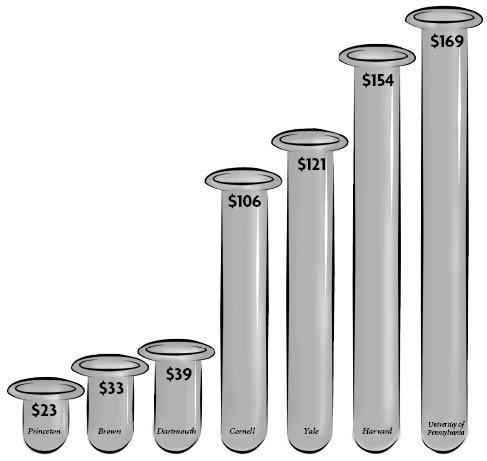
Stimulus money in millions of dollars for Ivy League universities. Dollar amount for Columbia could not be obtained.
Early last year, Harvard Medical School professor Timothy Mitchison pulled aside two scientists employed in his lab. Without more funding soon, Mitchison told them, he would have to let them go.
Today, thanks to a grant funded by the American Recovery and Reinvestment Act—President Barack Obama’s $787 billion stimulus package, which allocated $21.5 billion for research and development—the two still have their jobs.
Harvard has received more than $150 million in stimulus funding, which supported roughly 200 projects like Mitchison’s, according to Kevin Casey, the University’s chief lobbyist.
With spending from the National Institutes of Health declining in real terms over the past five years, competition for grant money has been fierce, and the percentage of successful NIH grant applications dropped from 32 percent in 1999 to 22 percent in 2008.
The recent injection of stimulus dollars, Harvard researchers and administrators say, has been an important lifeline.
“It’s been a little bit like Lipitor for the federal research system, unclogging the clogged arteries of research,” Casey says. “There is a lot of excitement around the country about the progress that will be made.”
But even as the Obama Administration proposed an additional increase in funding for NIH and National Science Foundation research grants in the 2011 budget this week, some researchers at the University are still concerned about the availability of financial support going forward.
‘SHOVEL-READY’ PROJECTS
Federal support for university-based research came amidst Harvard’s ongoing efforts to push for increased funding for the sciences.
University President Drew G. Faust testified before a Senate committee in 2008, stressing the importance of bolstering the NIH budget, which had flatlined since 2005.
Harvard lobbyists—working with a consortium of other universities and agencies while legislators drafted the stimulus bill last year—argued that research plays an important role in driving economic growth and development.
Basic science research creates jobs, and innovation serves as “a catalyst for ongoing stimulus,” Casey says.
By the time federal agencies had given additional research funding a green light, Harvard administrators and researchers had less than two years to submit grant proposals and spend stimulus money.
The Obama administration’s focus on “shovel-ready” projects meant that many Harvard researchers were able to move forward on projects that were not fully funded at the time.
Researchers awarded stimulus grants were able to start working “almost immediately,” Mitchison says—unlike in previous years, when they often waited a few months to receive the funds.
Read more in News
Alum’s Radio Show Spotlights World Issues












